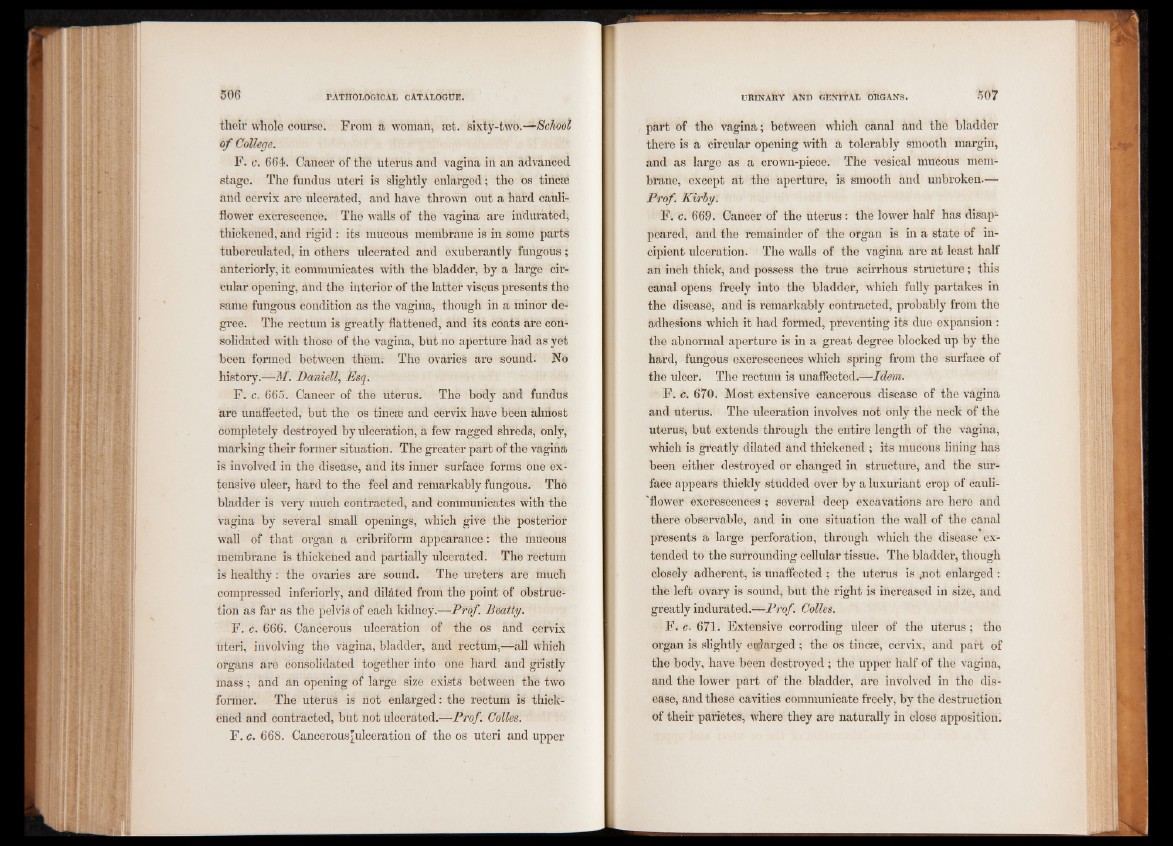
their whole course. Front a woman, set. sixty-two.—School
of College.
F. c. 664. Cancer of the uterus and vagina in an advanced
stage. The fundus uteri is slightly enlarged; the os tincse
and cervix are ulcerated, and have thrown out a hard cauliflower
excrescence. The walls of the vagina are indurated,
thickened, and rigid : its mucous membrane is in some parts
tuberculated, in others ulcerated and exuberantly fungous;
anteriorly, it communicates with the bladder, by a large circular
opening, and the interior of the latter viscus presents the
same fungous condition as the vagina, though in a minor degree.
The rectum is greatly flattened, and its cOats are consolidated
with those of the vagina, but no aperture had as yet
been formed between them. The ovaries are sound. No
history.—M. Daniell, Esq.
F. c. 665. Cancer of the uterus. The body and fundus
are unaffected, but the os tine® and cervix have been almost
completely destroyed by ulceration, a few ragged shreds, only,
marking their former situation. The greater part of the vagina
is involved in the disease, and its inner surface forms one extensive
uleer, hard to the feel and remarkably fungous.- The
bladder is Very much contracted, and communicates with the
vagina by several small openings, which give the posterior
wall of that organ a cribriform appearance : the mucous
membrane is thickened and partially ulcerated. The rectum
is healthy: the ovaries are sound. The ureters are much
compressed interiorly, and diluted from the point of obstruction
as far as the pelvis of each kidney.—Prof. Beatty.
F. c. 666. Cancerous ulceration of the os and cervix
uteri, involving the vagina, bladder, and recthm,—all Which
organs are consolidated together into one hard and gristly
mass; and an opening of large size exists between the two
former. The uterus is not enlarged: the rectum is thickened
and contracted, but not ulcerated.—Prof. Colles.
F. c. 668. Cancerous-[ulceration of the os uteri and upper
part of the vagina; between which canal and the bladder
there is a circular opening with a tolerably smooth margin,
and as large as a crown-piece. The vesical muCous membrane,
except at the aperture, is smooth and unbroken.—
Prof. Kirby.
F. c. 669. Cancer of the uterus: the lower half has disappeared,
and the remainder of the organ is in a state of incipient
ulceration. The walls of the vagina are at least half
an inch thick, and possess the true scirrhous structure; this
canal opens freely into the bladder, which fully partakes in
the disease, and is remarkably contracted, probably from the
adhesions which it had formed, preventing its due expansion :
the abnormal aperture is in a great degree blocked up by the
hard, fungous excrescences which spring from the surface of
the ulcer. The rectum is unaffected.—Idem.
F. c. 670. Most extensive cancerous disease of the vagina
and uterus. The ulceration involves not only the neck of the
uterus* but extends through the entire length of the vagina,
which is greatly dilated and thickened ; its mucous lining has
been either destroyed or changed in structure, and the surface
appears thickly studded over by a luxuriant crop of cauli-
' flower excrescences ; several deep excavations are here and
there observable, and in one situation the wall of the canal
presents a large perforation, through which the disease extended
to the surrounding cellular tissue. The bladder, though
closely adherent, is unaffected ; the uterus is mot enlarged :
the left GVary is sound, but the right is increased in size, and
greatly indurated.—Prof. Colles.
F. c. 671. Extensive corroding ulcer of the uterus; the
organ is slightly enlarged ; the os tin&e, cervix, and part of
the body, have been destroyed ; the upper half of the vagina,
and the lower part of the bladder, are involved in the disease,
and these cavities Communicate freely, by the destruction
of their parietes, where they are naturally in close apposition.